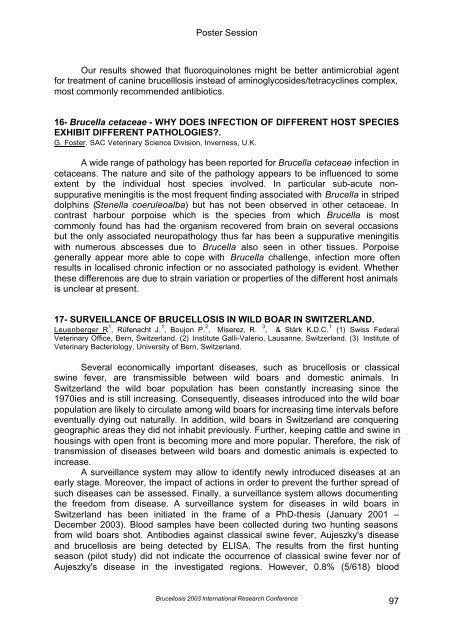Brucellosis 2003 proceedings - PHIDIAS
Brucellosis 2003 proceedings - PHIDIAS
Brucellosis 2003 proceedings - PHIDIAS
Create successful ePaper yourself
Turn your PDF publications into a flip-book with our unique Google optimized e-Paper software.
Poster Session<br />
Our results showed that fluoroquinolones might be better antimicrobial agent<br />
for treatment of canine brucelllosis instead of aminoglycosides/tetracyclines complex,<br />
most commonly recommended antibiotics.<br />
16- Brucella cetaceae - WHY DOES INFECTION OF DIFFERENT HOST SPECIES<br />
EXHIBIT DIFFERENT PATHOLOGIES?.<br />
G. Foster. SAC Veterinary Science Division, Inverness, U.K.<br />
A wide range of pathology has been reported for Brucella cetaceae infection in<br />
cetaceans. The nature and site of the pathology appears to be influenced to some<br />
extent by the individual host species involved. In particular sub-acute nonsuppurative<br />
meningitis is the most frequent finding associated with Brucella in striped<br />
dolphins (Stenella coeruleoalba) but has not been observed in other cetaceae. In<br />
contrast harbour porpoise which is the species from which Brucella is most<br />
commonly found has had the organism recovered from brain on several occasions<br />
but the only associated neuropathology thus far has been a suppurative meningitis<br />
with numerous abscesses due to Brucella also seen in other tissues. Porpoise<br />
generally appear more able to cope with Brucella challenge, infection more often<br />
results in localised chronic infection or no associated pathology is evident. Whether<br />
these differences are due to strain variation or properties of the different host animals<br />
is unclear at present.<br />
17- SURVEILLANCE OF BRUCELLOSIS IN WILD BOAR IN SWITZERLAND.<br />
Leuenberger R. 1 , Rüfenacht J. 1 , Boujon P. 2 , Miserez, R. 3 , & Stärk K.D.C. 1 (1) Swiss Federal<br />
Veterinary Office, Bern, Switzerland. (2) Institute Galli-Valerio, Lausanne, Switzerland. (3) Institute of<br />
Veterinary Bacteriology, University of Bern, Switzerland.<br />
Several economically important diseases, such as brucellosis or classical<br />
swine fever, are transmissible between wild boars and domestic animals. In<br />
Switzerland the wild boar population has been constantly increasing since the<br />
1970ies and is still increasing. Consequently, diseases introduced into the wild boar<br />
population are likely to circulate among wild boars for increasing time intervals before<br />
eventually dying out naturally. In addition, wild boars in Switzerland are conquering<br />
geographic areas they did not inhabit previously. Further, keeping cattle and swine in<br />
housings with open front is becoming more and more popular. Therefore, the risk of<br />
transmission of diseases between wild boars and domestic animals is expected to<br />
increase.<br />
A surveillance system may allow to identify newly introduced diseases at an<br />
early stage. Moreover, the impact of actions in order to prevent the further spread of<br />
such diseases can be assessed. Finally, a surveillance system allows documenting<br />
the freedom from disease. A surveillance system for diseases in wild boars in<br />
Switzerland has been initiated in the frame of a PhD-thesis (January 2001 –<br />
December <strong>2003</strong>). Blood samples have been collected during two hunting seasons<br />
from wild boars shot. Antibodies against classical swine fever, Aujeszky's disease<br />
and brucellosis are being detected by ELISA. The results from the first hunting<br />
season (pilot study) did not indicate the occurrence of classical swine fever nor of<br />
Aujeszky's disease in the investigated regions. However, 0.8% (5/618) blood<br />
<strong>Brucellosis</strong> <strong>2003</strong> International Research Conference<br />
97
















